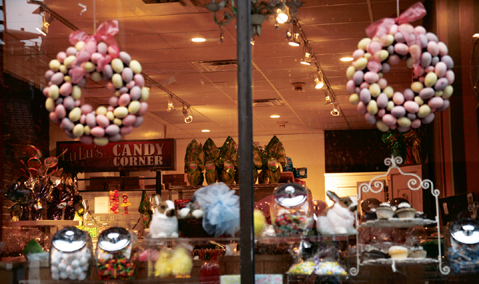
These cookies are moist and delicious and simple to assemble. In the Italian cuisine, ricotta seems to be able to resurface deliciously in every course. Since it is a by-product of making cheese, the shepherds had plenty of ricotta. Hence, many desserts are still made from it, like these delicious cookies.
MAKES ABOUT 3½ DOZEN
2¼ cups all-purpose flour
1 teaspoon baking powder
Pinch kosher salt
1 cup granulated sugar
½ cup (1 stick) unsalted butter, at room temperature
2 large eggs
8 ounces fresh ricotta, drained
½ teaspoon vanilla extract
FOR THE GLAZE
2 teaspoons lemon zest, plus ¼ cup lemon juice
2 cups confectioners’ sugar, sifted
Preheat oven to 325 degrees F. Sift together flour, baking powder, and salt into a bowl, and set aside.
Line two baking sheets with parchment paper.
Cream the sugar and butter in a mixer fitted with the paddle attachment on high speed until light and fluffy, about 2 minutes. Reduce the speed to medium, and crack in the eggs one at a time, beating well between additions. Plop in the ricotta, vanilla, and lemon zest, and beat to combine. Add the flour mix, and beat on low until just combined, but do not overmix.
Drop the dough in heaping tablespoons onto the baking sheets. Place in oven, and bake, rotating pans halfway through the baking time, until the cookies are puffed, golden, and cooked all the way through, about 20 to 22 minutes. Remove from oven, and cool on wire racks.
When the cookies are completely cool, make the glaze. In a bowl, whisk together the confectioners’ sugar and lemon juice to make a smooth glaze. Adjust the consistency with a little water or more confectioners’ sugar to make the glaze thick enough to stick to the cookies when dipped. Hold each cookie with two fingers, then dip the top of the cookie in the glaze and let dry on racks until all are done. Let dry for 2 hours before storing.
This is one of the most classic Italian American cookies, and it is one of the easiest to make. In Italian American culture, these are simply known as pinoli cookies, the word “pinoli” referring to the pine nuts that top the cookies, a distinct Sicilian twist.
The personal element in making this cookie is to ask yourself if you like it chewy or crumbly crisp—the difference is all in the baking time. With the timing given below, they will be a bit chewy, but of course it depends on how big you make them. Oh, so many variables in cooking!
MAKES ABOUT 30 COOKIES
Two 7-ounce tubes almond paste
1 cup sugar
2 large egg whites
Finely grated zest of 1 orange
1½ cups whole pine nuts
Preheat oven to 350 degrees F. Line two baking sheets with parchment.
Crumble the almond paste into the work bowl of a food processor and process until the paste is in fine crumbs. Sprinkle in the sugar with the motor running. Once the sugar is incorporated, add the egg whites and orange zest. Process to make a smooth dough, about 20 to 30 seconds.
Spread the pine nuts on a plate. Form the dough into 2-tablespoon-sized balls by rolling it between the palms of your hands, then roll the dough in the pine nuts until coated, then place on baking sheets. Bake until lightly golden and springy to the touch, about 13 to 15 minutes. Let cool on baking sheets for about 5 minutes, then transfer the cookies to cooling racks to cool completely.

Easter egg wreaths adorn windows at Lulu’s Sweet Shop in Boston’s North End during the Easter holiday season.
There are many traditional Italian almond-paste cookies, but rainbow cookies seem to have been created in America by Italian American immigrants to honor the colors of the Italian flag. The recipe requires patience, but it is not difficult. As with most baking recipes, follow the instructions carefully and you will be rewarded with cookies that everybody loves and that keep moist for more than a week. You can find them in Italian bakeries year-round, but they are especially popular at Christmastime.
MAKES ABOUT 3 DOZEN
2½ sticks unsalted butter, softened, cut into pieces, plus more for the pans
2 cups all-purpose flour, plus more for the pans
8 ounces almond paste
1 cup sugar
4 large eggs, separated
½ teaspoon kosher salt
1 teaspoon red food coloring (gel or paste preferred)
1 teaspoon green food coloring (gel or paste preferred)
Two 15-ounce jars smooth (not chunky) apricot jam
1½ pounds bittersweet chocolate, chopped
Preheat the oven to 350 degrees F. Butter and flour three 15-by-10-inch rimmed sheet pans, and line the bottoms of the pans with parchment paper.
Combine the almond paste and all but 2 tablespoons of the sugar in an electric mixer fitted with the paddle attachment. Mix on medium speed until you have fine crumbles. Add the butter, a few pieces at a time, and pulse until well mixed. Plop in the egg yolks, one at a time, and mix until the batter is smooth. Sprinkle in the salt, and mix. Sift in the flour, and mix until just combined.
Whisk egg whites in a bowl until foamy. While whisking, slowly add the remaining 2 tablespoons sugar, and whisk until firm peaks form. Fold about a third of the egg whites into the batter to lighten it, then gently fold in remaining egg whites.
Divide the batter evenly into three bowls. Leave one bowl plain, without any coloring. Add the red food coloring to one bowl, stirring to make a deep-salmon color. Add the green food coloring to the last bowl, stirring to make a medium-green color. Spread batter into each of the prepared pans with a spatula. Bake, rotating pans to opposite racks, until the cakes are cooked through and just beginning to brown around the edges, about 8 to 10 minutes. Remove from oven, let the cakes cool completely on wire racks, then remove from pans.
Trim each of the layers to even out the thickness of the cakes. Put the green cake layer back, cut side up, into one of the lined pans. Spread one jar of jam over the cake, almost all the way to the edges. Place the plain layer of cake on top of the jam. Spread the remaining jar of jam almost all the way to the edges of the plain layer. Place the red layer on top of the jam, cut side up. Wrap the entire cake in plastic, and top with another pan, weighted with cans. Chill in the refrigerator 4 hours or overnight.
Melt chocolate in a double boiler. Unwrap the cake, and place on a wire rack over a rimmed baking sheet. Pour and spread the chocolate over the top of the cake, using a spatula to guide the chocolate over the top and down the sides of the cake. If the kitchen is cool, let the chocolate harden that way; if it is warm, clear a space in the refrigerator to place the cake, and let the chocolate harden. When the chocolate is about halfway set, gently rake the topping with the tines of a fork or a dough scraper with dentals, starting from the end of the chocolate covering all the the way to the other end, slightly undulating the lines as you move along. Repeat until all of the chocolate has indented stripes. Let the chocolate set completely.
Using a serrated knife, cut the set and decorated layers into three dozen rectangles, using the outer sides to form perfectly cut rectangles.
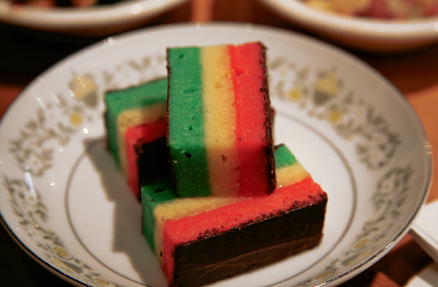
The rainbow cookies at Torrisi Italian Specialties in New York City’s Little Italy
As much as Italians would like to claim the fig as their own, it has deep origins somewhere in Mesopotamia. Then it made its way into the Middle East and the rest of the world. The Egyptians adored the fig and praised it as a medicinal and delicious fruit. Fig breads and sweets were made way before the Italians started, but you cannot take away the importance the fig cookie has on St. Joseph’s Day for the Italian culture. As the legend goes, during a year of drought and famine in Sicily, people would gather and pray to St. Joseph for help. St. Joseph responded by sending heavy rains. To this day Sicilians respond by making the St. Joseph’s table full of offerings, and among them must be the St. Joseph’s fig cookies.
MAKES ABOUT 4½ DOZEN
½ cup honey
6 tablespoons grappa or brandy
4 teaspoons orange juice
2 cups diced dried black figs
3¾ cups all-purpose flour
½ cup granulated sugar
1½ teaspoons baking powder
¼ teaspoon kosher salt
2 large eggs
6 tablespoons milk
2 teaspoons lemon zest
¼ teaspoon ground cinnamon
½ cup walnut pieces
FOR THE GLAZE
1½ cups confectioners’ sugar, or as needed
3 tablespoons milk, or as needed
Bring the honey, grappa, and orange juice to a boil in a saucepan. Add the figs, and bring to a simmer. Simmer until the figs are plumped, about 2 to 3 minutes. Remove from heat, and let cool thoroughly while you make the dough.
Combine the flour, sugar, baking powder, and salt in a food processor. Beat together the eggs and milk in a small bowl. Pour the egg-milk mixture into the dry ingredients with the processor running, and pulse until the dough forms a ball, about 15 to 20 seconds. Knead the dough on the counter once or twice, then wrap in plastic wrap and let it rest in the refrigerator at least 1 hour or until firm.
When the fig filling is cool, scrape it into a food processor and sprinkle in the lemon zest and cinnamon, processing all to make a smooth paste. Then add the walnuts, and pulse a few more times, leaving the nuts slightly chunky. Transfer the filling to a bowl, and freeze until firm, about ½ hour.
Preheat the oven to 350 degrees F. Divide the dough in half, and roll one half, between sheets of parchment paper, into a rectangle about 16 by 7 inches. Cut the rectangle in half to make two long strips. With the palms of your hands, roll a quarter of the filling into a log and set it down on the center of one strip. With a pastry brush, lightly wet one long edge of the strip, then, using the parchment paper underneath, begin to roll the dough until you have covered the filling and the two ends of the dough meet. Press gently and seal the log. Roll the seam underneath, and flatten the top slightly with the palm of your hand. Repeat with the remaining dough and filling; you will now have four long logs with filling in the center.
Cut the logs into 1-inch lengths using a wet knife, and place in the same position on parchment-lined baking sheets. Place in oven and bake until golden, about 15 to 20 minutes. Transfer the cookies to a wire rack and cool completely.
To glaze cookies: Sift the confectioners’ sugar into a bowl, and whisk in the milk to make a smooth glaze. Dip a cookie into the glaze; it should stick to the cookie in a thin layer. If not, adjust the consistency of the glaze with more milk if too dense or confectioners’ sugar if too loose.
Let the glazed cookies dry on wire racks.

When we decided to open Lidia’s in Kansas City in 1998, in the Freight House, in the Crossroads Arts District, near Crown Center, it was our first venture outside of New York City. I get asked all the time: why Kansas City? It is smack in the middle of America, and, after all, we wanted to share our product, traditional Italian food, with America beyond New York. Little did we realize how effective the Italian immigrants before us had been in bringing Italian culture and food to Kansas City.
Columbus Park served as Kansas City’s Italian neighborhood; it is not far from the city center, with the Missouri River defining one of the neighborhood’s boundaries. Columbus Park was the area in which many immigrants got off the riverboat; many Italian immigrants came to Kansas City between 1890 and 1920 to work on the railroad and in the meat-packing industries, and Columbus Park became the Italian ethnic neighborhood, full of mainly Sicilian immigrants.
I wanted to know the history of the Italians before me in Kansas City, so, on a misty March morning, Tanya and I went to Columbus Park to see what Italian heritage was still there. We were told to visit Scimeca’s Italian Sausage Co., which had been making sausages for over seventy-five years, and La Rocca Grocery. Mike greeted us at La Rocca’s, but it is Joseph La Rocca who runs the shop, with his two nephews Mike and Frank. One could see, from all the black-and-white pictures on the wall, that the store had a family story to tell. The story was of Italy, of Italian food products needed by the immigrants, and now by stores and restaurants selling and cooking Italian.
The La Roccas were very generous with their time and information, so much so that Mike walked us two blocks over to the Holy Rosary Church, which is the epicenter of all things Italian in the neighborhood. The ladies of the church still put on quite an altar for St. Joseph’s Day, and, as luck would have it, we were visiting in March, a few days before St Joseph’s. When Mike La Rocca took us to the Holy Rosary Church, he showed us the basement, where about fifty of the local Italian women and men were busy baking, icing, and molding the cakes and cookies that would decorate St. Joseph’s altar. We could have been in Sicily, the setting was so real and intense.
On the way back, we passed La Sala’s Deli, started in 1921, which is still making po’ boy sandwiches today. The roads are lined with small two-story homes, very similar to the homes in many other Little Italys across America. All have the essential porch for the evening chiachierata, for which families and friends gather. The Italians are well incorporated in the matrix that is Kansas City. The Mirabiles are a long-established family in the restaurant business in Kansas City; even before we opened a restaurant there, I recall traveling with Mrs. and Mr. Jasper Mirabile, Sr., to Italy, with Gruppo Ristoratori Italiani. He was a chef dedicated to his Italian roots, always curious, and wanting to bring the regional food of Italy back to his restaurant, Jasper’s. His son Jasper Jr. now carries on the legacy of his Italian father and continues to run Jasper’s, a great Italian restaurant.
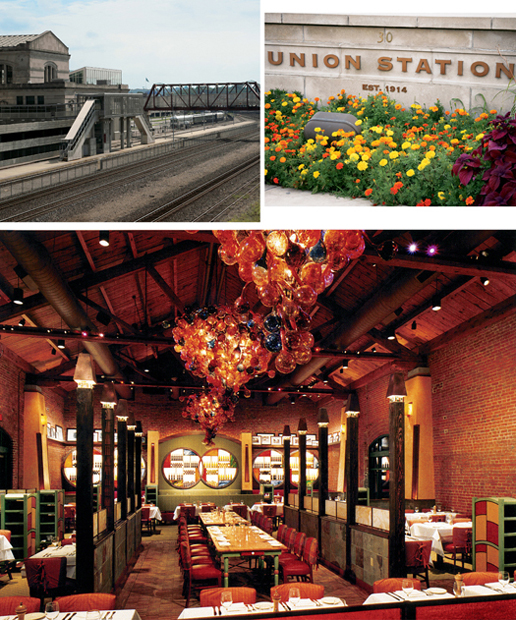
Union Station in Kansas City, Missouri; the inside dining room at Lidia’s Kansas City
The Parisi Brothers line have supplied the Kansas City area with traditional Italian products for generations. They distribute Lidia’s Pasta and Lidia’s Sauce in the Midwest, and have hundreds of thousands of pounds of Italian cheese aging in the Kansas City caves.
The Garozzos are a family that I know less well, but they have done Italy proud with their Italian restaurants in Kansas City. And the American Italian Pasta Company, North America’s largest producer of dry pasta, is based in Kansas City, in the heart of the Midwest, where there is plenty of grain to make pasta.

These traditional Italian cookies are as easy as it gets, and everybody loves them. The citrus flavoring renders them inviting, and most likely you have had them at Italian family celebrations such as weddings, confirmations, and baptisms. Not too sweet, these cookies will keep for a week or two in a cookie container.
MAKES ABOUT 6½ DOZEN
3 cups all-purpose flour
2 teaspoons baking powder
¼ teaspoon kosher salt
1½ sticks unsalted butter, at room temperature
½ cup plus 1 tablespoon granulated sugar
3 large eggs
1 teaspoon vanilla extract
2 tablespoons orange juice
2 tablespoons lemon juice
1 tablespoon orange zest
FOR THE GLAZE
2½ cups confectioners’ sugar, or as needed
¼ cup orange juice, or as needed
Sift together the flour, baking powder, and salt into a bowl. Cream the butter and sugar in a mixer fitted with the paddle attachment on medium speed until light and fluffy, about 2 minutes. Crack in the eggs, one at a time, beating well between additions. Pour in the vanilla, the juices, and the zest, and beat to combine. Turn the mixer off, pour in the flour mixture, and mix on low just to combine. Wrap the dough in plastic, and let rest in refrigerator 1 hour.
Roll the dough into four logs, about 1½ inches in diameter and 10 to 12 inches long. Chill or freeze the logs for 20 minutes, until firm enough to cut without losing their shape.
Preheat the oven to 350 degrees F. Cut the logs into ½-inch rounds, and place on parchment-lined baking sheets. Place in oven, and bake until the cookies are golden, about 15 minutes. Remove, and cool the cookies completely on wire racks.
To glaze the cookies: Sift confectioners’ sugar into a bowl, and whisk in the orange juice to make a smooth glaze. Dip a cookie in the glaze; it should stick to the cookie in a thin layer. If not, adjust the consistency of glaze with more juice or confectioners’ sugar. Dip the top of the baked cookies in glaze, and let dry on wire racks.
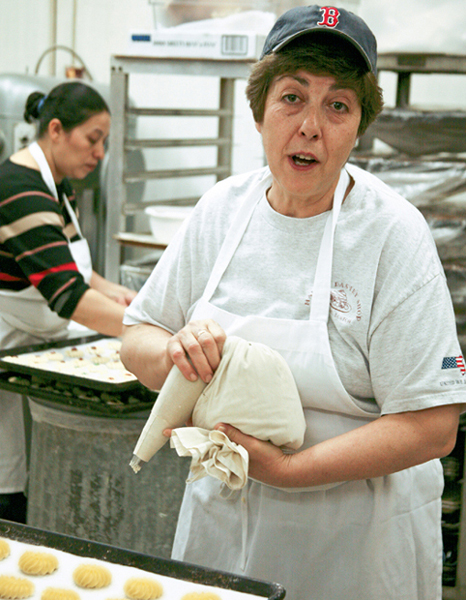
Maria Merola of Maria’s Pastry Shop in Boston gets ready for the holidays.
Every region of Italy makes some form of these fried dough pastries called zeppole. They can be sweet or savory, with goodies embedded in the dough or stuffed after frying. Zeppole are especially prepared for St. Joseph’s Day (March 19), during Lent, for the Christmas Vigilia (Eve), and on holidays. When sweet, they are usually dusted with powdered sugar and served hot. You can find them in every Little Italy in the United States around the holidays.
MAKES ABOUT 1½ DOZEN
6 cups vegetable oil, or as needed, for frying
FOR THE FILLING
2 cups fresh ricotta, drained
1 cup mascarpone
3 tablespoons amaretto
½ cup confectioners’ sugar, sifted, plus more for dusting
2 tablespoons finely chopped candied lemon peel
2 tablespoons finely chopped candied citron or orange peel
2 tablespoons finely chopped bittersweet chocolate or mini–chocolate chips
FOR THE DOUGH
4 tablespoons unsalted butter
1 tablespoon granulated sugar
½ teaspoon kosher salt
1 cup all-purpose flour, sifted
Finely grated zest of 1 lemon
4 large eggs, at room temperature
Heat the vegetable oil in a wide saucepan to 350 degrees F. (The oil should be an inch or two deep.)
For the filling: Whisk together the ricotta, mascarpone, amaretto, and confectioners’ sugar in a bowl until smooth. Stir in the candied peel and chocolate. Refrigerate the filling while you make the zeppole.
Combine 1 cup water, the butter, sugar, and salt in a medium saucepan over medium heat. Bring to a boil, stirring to melt the butter. While stirring, add the flour and zest all at once. Cook, stirring constantly, until the dough dries out and pulls away from the sides of the pan. Remove from heat, and add the eggs one at a time, stirring vigorously to incorporate one before adding the next, until the dough is completely smooth.
Drop a batch of zeppole in 2-tablespoon dollops (a small ice-cream scoop is perfect for this) into the oil, making sure you don’t crowd them in the pan, because they will grow in size. Fry the zeppole, turning on all sides, until light and golden brown all over, about 5 minutes per batch. Drain on paper towels, and repeat with the remaining dough.
To serve, when cold cut the zeppole in half with a serrated knife and with a pastry bag pipe the filling onto the bottom half. Cover and dust with additional confectioners’ sugar if desired.
Fried dough balls rolled in honey, collected in a mound and topped with sprinkles, is a typical Christmas vision at Italian American bakeries across the United States. What I found fascinating is that even though the cookies and prepared food are very good, it is all about memories and traditions. Struffoli seem to be a big part of that Italian American memory.
SERVES 8 TO 10
4 cups all-purpose flour
½ cup plus 1 tablespoon sugar
Finely grated zest of 1 lemon
Finely grated zest of 1 orange
¼ teaspoon ground cinnamon
Pinch kosher salt
4 large eggs
1 teaspoon vanilla extract
2 tablespoons unsalted butter, cut into small pieces
2 cups honey
Vegetable oil, for frying
Sprinkles, for garnish
Pulse together the flour, 1 tablespoon sugar, the lemon zest, orange zest, cinnamon, and salt in a food processor. Whisk together the eggs and vanilla in a separate bowl. Pour the egg mixture into the food processor with the motor running, and then drop in the butter pieces. Process until a smooth dough forms, about 30 seconds. Knead the dough on the counter a few times, then wrap in plastic and let rest at room temperature for 1 hour.
Make the syrup: Combine the honey, the remaining ½ cup sugar, and ⅓ cup water in a medium skillet over medium heat. Bring to a boil, and cook until syrupy, about 6 to 7 minutes.
In the meantime, heat 1 inch of vegetable oil in a pot or straight-sided skillet to about 365 degrees F, or until a piece of dough sizzles on contact. Pinch off a golf-ball-sized piece of dough, and roll into a rope about ½ inch wide. Cut the rope of dough into pieces the size of a hazelnut and roll into balls. Repeat until all the dough is used.
Fry the struffoli in batches until puffed and deep golden, about 3 to 4 minutes per batch. Drain on a paper-towel-lined baking sheet, and repeat with the remaining struffoli.
Toss the struffoli in the hot honey syrup, in batches, as many at a time as you can fit without crowding. Roll the struffoli in the syrup until well coated, then scoop them up with a slotted spoon or strainer, and drain off the excess syrup. Stack the struffoli in layers on a plate to form a cone, sprinkling each layer with the sprinkles as you stack. Repeat until all the struffoli are coated in the honey syrup and covered in sprinkles. Drizzle the completed stack of struffoli with any remaining syrup, if you wish.
Just a short ride from New York City, Hammonton, New Jersey, is a town which has one of the densest concentrations of Italians in the United States as well as being the blueberry capital of America. With a population of about thirteen thousand, 55 percent are of Italian heritage. Italian immigrants were skilled at agriculture and knew well how berry bushes grew. Blueberry farming in Hammonton offered jobs and the Italian immigrants came.
The Italian immigrant farmers came to New Jersey mostly from southern Italy and from Sicily. These pioneers arrived in southern New Jersey looking for homes not too far from the sea, where the climate was congenial and the land was cheap. Until 1850, the Pine Barrens of New Jersey were looked upon as wasteland, not good farming land for dairymen or the grain grower. But the sandy soil was perfect for growing berries. Although blueberries are not a fruit that was used in Italy, wild or cultivated berries are a big part of the Italian table. As a child, I collected wild blackberries from the thorny bushes in the forest and climbed the mulberry tree to harvest its delicate fruit. So, when I found myself in the midst of the blueberry bushes at Indian Brand Farms, I had my hands full in no time and ate my fill, since I love blueberries. Indian Brand Farms was established in 1895 by Michael DiMeo, who emigrated from Sulmona, in Abruzzo. It is still run by the brother-and-sister team Billy DiMeo and Ann DiMeo Montellite, and their family welcomed us warmly with a tableful of blueberries prepared in many ways, from bowls of blueberry jam, to blueberry cobbler, to a blueberry tart, scones, and ice cream (topped by blueberry crème fraîche). Even the plates had blueberries painted on them.

Billy DiMeo and sister Ann Montellite at their home in Hammonton, New Jersey—the blueberry capital of the world!
Not too far away, in Woolwich Township, we visited the Maugeri Farms, known as one of the largest Italian family-operated farms in New Jersey. Sure enough, when we arrived the whole family, three generations, were waiting for us with a tableful of food. Mamma Anna Maugeri served Tanya and me a wonderful lunch of roasted peppers, eggplant parmigiana, asparagus fritters, and tomato-and-cucumber salad, all just picked that morning, as well as some chicken cutlets thrown in for good measure. It felt like a homecoming, a welcome such as my mother would prepare.
But we came to the Garden State to see the beautiful vegetables, and Joe Maugeri, Jr., took us to see the never-ending fields of wonderful salad tomatoes, which extended to another endless field of plum and Roma tomatoes. Then came the yellow bursts of zucchini flowers, and certainly underneath those flowers were the crispy zucchini; then the shiny purple eggplants and peppers—and on and on the fields went. This vibrant family farm was started in 1922 by Salvatore Maugeri, and the business today, now over six hundred acres, is operated by brothers Sam and Joe Jr., all under the watchful eye of Mamma Anna.

With brothers Joe Jr. and Sam Maugeri, along with the matriarch Anna Maugeri, while visiting the Maugeri farm in southern New Jersey
When I first came to the United States as a young immigrant in 1958, the Catholic Relief Services, which brought us here, found a home for us in North Bergen, New Jersey. My American roots first took hold in New Jersey, and I feel quite at home here. And I thank my following in New Jersey, for whenever I do an event or a book signing here now, the response is tremendous.

Neither blueberries nor cobblers are Italian, but one of the largest and oldest blueberry farms in what is called the blueberry capital of the world is Indian Brand Farms, run by the DiMeo family of New Jersey. I had a wonderful blueberry cobbler when I visited, and my version of that recipe is simple and delicious.
SERVES 6 TO 8
FOR THE FILLING
1 cup sugar
Juice of 1 lemon
3 tablespoons cornstarch
2 pints blueberries
2 bananas, peeled and sliced ½ inch thick
FOR THE TOPPING
1½ cups all-purpose flour
¾ cup sugar
1½ teaspoons baking powder
Pinch kosher salt
1½ sticks unsalted butter, cold, cut into small pieces
½ cup sliced almonds
Preheat oven to 400 degrees F.
Whisk together the sugar, lemon juice, and ⅓ cup water in a 9-inch deep-dish pie plate. Whisk in the cornstarch until smooth. Add the blueberries and bananas, and toss to coat.
Pulse to combine the flour, sugar, baking powder, and salt in a food processor. Drop in the butter pieces and almond slices, and pulse five or six times, until the dough looks like coarse crumbs. Drizzle in ⅓ cup cold water, and pulse just until the dough comes together. Dollop the dough in heaping spoonfuls over the blueberry mixture.
Place in oven, and bake until the blueberries are bubbling and the topping is cooked all of the way through and golden brown, about 35 to 40 minutes. Serve warm.
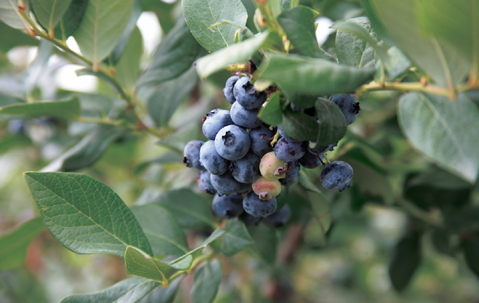
Perfect blueberries, ripe for picking, at Indian Brand Farms in Hammonton, New Jersey
The crostata, or tart, is as common in Italy as pie is in America. It is one of the best ways to showcase seasonal fruit as a dessert. Once the crust is made for the filling, add some marzipan and some plump, juicy seasonal blueberries. There is no need to add cornstarch to bind the juice of the berries—they will nestle into the marzipan.
SERVES 8 OR MORE
FOR THE CRUST
1¼ cups all-purpose flour
⅓ cup sugar
¼ teaspoon kosher salt
1 stick unsalted butter, cold, cut into small pieces
FOR THE FILLING
10-ounce can almond paste
½ cup sugar
2 large eggs
2 tablespoons all-purpose flour
1 pint blueberries
¼ cup pine nuts, lightly toasted
For the crust: Pulse to combine the flour, sugar, and salt in the work bowl of a food processor. Drop in the butter pieces, and pulse just until the dough comes together in clumps, about ten to fifteen pulses. Press the dough into the bottom and up the sides of a 9-inch tart pan. Let the crust rest in the refrigerator for 30 minutes.
Preheat the oven to 325 degrees F. Combine the almond paste and sugar in the same food-processor bowl (no need to wash it). Process until you have fine crumbs, then crack in the eggs and sprinkle in flour. Process until smooth.
Spread the almond filling in an even layer in the chilled tart shell. Top with the blueberries, and sprinkle with the pine nuts. Bake until the crust is deep golden brown and the filling is set, about 1 hour to 1 hour and 20 minutes.

Holding the freshly picked plump blueberries in the fields of Indian Brand Farms in Hammonton, New Jersey
Maybe Paul Revere should have shouted, “The Italians are coming!” instead of the British. He might have done so had he known that, at the area’s peak in 1930, forty-four thousand Italian immigrants would be in the area, less than one square mile, known as the North End. The first Italian immigrants came in the 1860s from Genoa and settled in a three-block area off Fulton Street. The Genoese were followed by the Campanians, followed by the Sicilians, the Avellinese, the Neapolitans, and the Abruzzesi. Paesani tended to stick together even within the North End, creating micro-neighborhoods based on Italian regionality.
The North End is Boston’s oldest neighborhood. In colonial days, it was an affluent area, and shipbuilders and merchants had businesses near the wharf. Eventually, the Bostonians opted for larger living quarters, and the houses became walk-up tenements for Irish, then Jewish, and then Italian immigrants. The Italians began as laborers at the port: peddlers, fishermen, and dockworkers. But by 1920, the North End had twenty-eight Italian physicians, six Italian dentists, eight Italian funeral homes, and, along just one block of Hanover Street, four or five Italian barbershops.
Most businesses were family run and owned, and many of them turned into success stories. Pietro Pastene, for instance, started a food store in the North End in 1874 which would later become the New York–based Pastene Corporation. Boston Macaroni Company, headed by John Ponte, began operations in 1890, and the Prince Macaroni Company started by three Sicilian friends—LaMarca, Seminara, and Cantella. “Wednesday is Prince Spaghetti Day” became a famous slogan in the late 1960s.
With many of its cobblestone streets still intact, and most of its merchants still of Italian descent, the North End has become a place to go for good Italian meals, pastries, or specialties, and a tourist destination for those visiting Boston. Of the Little Italys I have visited in the United States, the North End of Boston and Arthur Avenue in New York City are among the most vibrant remaining. The North End still retains the nostalgic old-neighborhood feel, but offers all the elements for a contemporary Italian lifestyle. I go to Boston often because of business, since my station, WGBH, is in Brighton. I used to go periodically to visit with Julia Child when she lived in Cambridge. My son Joseph attended Boston College. For four years we would visit him and enjoy the city, and I would take him and his schoolmates by the dozen to lunches and dinners. Durgin-Park, in Quincy Market, was a stop for oversized prime ribs, but a visit to the North End was on the agenda every time.

Owner Jeff Cirace of Cirace & Son by the wall of amari
Sometimes it was for a cannoli or sfogliatella at Maria’s Pastry Shop, and feisty Maria Merola would always be there to charm us. Other times we would pick up Italian sandwiches at Salumeria Italiana, on Richmond Street, a quaint specialty store where one can still find everything Italian and delicious. The selection of Italian restaurants is endless in the North End: many of the old neighborhood grocery stores, fruit vendors, clothiers, and cobblers have disappeared and have been replaced by restaurants. The neighborhood today is still composed of more than 41 percent Italian Americans, and the lingua franca in the neighborhood is still Italian.
On a recent visit on a rainy day in May, Tanya and I wanted to visit Jeff Cirace at Cirace & Son. This 104-year-old wine and liquor store, which has always been in the Cirace family, carries more than three hundred different labels of grappa. A whole wall is dedicated to Italian amari, and Jeff prides himself on the limoncello that is made in Italy just for his store. His Italian-wine selection is extensive as well, all from good producers, and I was delighted to see the Bastianich Vespa on the shelves. Jeff is a man passionate about his profession, and although the “& Son” is on the door of this charming store, he made sure to tell me that his daughter, an attorney, just moved above the store, in the house where his grandparents lived, and wants to carry on the tradition.
Keeping with tradition, we went to visit the Sulmona Meat Market on Parmenter Street. Domenico Susi, the owner, was behind the counter on that rainy morning. He bought the store from the original owners in the 1960s, and now he and his son run the family business, making more than 120 pounds of hand-tied sausages a day, for which they continue to win awards. Business is good, but he laments that there used to be fifteen butchers in the North End and now there are only two.
It was pouring, and time for a cappuccino, so we made it to Modern Pastry, on Hanover Street. We ordered cappuccino, an ampolina (a stuffed pastry that looks like a lobster tail), and a piece of their famous ricotta pie. Soon enough John Picariello, who runs the shop with his father, Giovanni, came over eagerly to share his family story. There are six generations of pastry chefs in the family, and as John sat at our table to continue the story, more and more pastries arrived, and we were obliged to keep tasting as we listened to their Italian story in Boston’s North End.
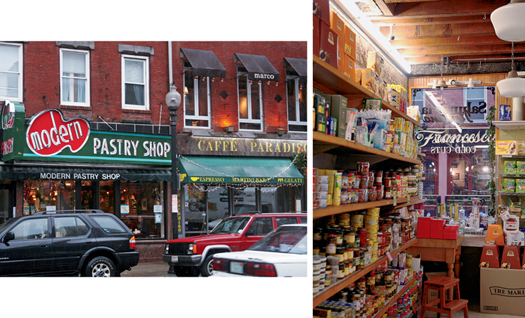
Sweet happenings at Modern Pastry Shop in the North End of Boston; Salumeria Italiane—a great resource for Italian shopping

I guess you could consider this one of many Bundt cakes, but it is different indeed. Though it is shaped and baked in a Bundt pan, the almond slices and the abundant soaking in rum syrup make it Italian American, as it has been made for generations at the Scialo Bros. Bakery in Providence, Rhode Island. Second-generation daughter Carol Gaeta still mans the store, and on the morning when we appeared unannounced, a happy couple, mother and father of the bride, were picking up all the traditional cookies and cakes to be set out at the wedding reception that evening. Italian Americans from Rhode Island, now living in Chicago, they wanted to celebrate this momentous occasion in their family’s Italian American style in their native state.
Once the excited mother of the bride had packed all her goodies in the car and left, we had an opportunity to chat with Carol. She took us in the back, where baking sheets full of the butter-rum cake were lined up for soaking. Carol was generous enough to let us taste it, and gave us this delicious recipe to share with you.
SERVES 10 TO 12
FOR THE CAKE
2 sticks unsalted butter, at room temperature, plus more for buttering the pan
6 ounces almond slices, finely ground in a food processor, plus 2 ounces almond slices, toasted
4 cups all-purpose flour
1 tablespoon baking powder
½ teaspoon kosher salt
2 cups sugar
3 large eggs
6 large egg yolks
Zest of 1 large lemon
⅓ cup milk
FOR THE SYRUP
¾ cup sugar
½ cup dark rum
Preheat the oven to 350 degrees F. Brush the inside of a 12-cup-capacity nonstick Bundt pan with softened butter, and coat the pan with the 2 ounces of toasted almond slices. Stir together the flour, ground almonds, baking powder, and salt in a bowl.
Cream the two sticks of butter and the sugar in a mixer fitted with the paddle attachment on medium-high speed until light and fluffy, about 2 to 3 minutes. Add the eggs and yolks a few at a time, letting them get incorporated before adding more. When all the eggs and yolks have been added, add the lemon zest and beat on high for 1 minute. Pour in half of the flour with the mixer on low speed. Once the flour is incorporated, pour in the milk. Finish with the remaining flour, and mix just until you have a smooth batter.
Pour the batter into the prepared pan, and bake until a tester inserted in the center of the cake comes out clean, about 1 hour to 1 hour and 10 minutes. Cool the pan on a rack for 15 minutes. Loosen the sides of the cake with a paring knife, and invert onto the rack.
Make the syrup while the cake is still warm: Combine 2 cups water, the sugar, and the rum in a small saucepan. Bring to a boil, and cook down by about a quarter, or until you have a thin syrup. Transfer the warm cake to a rimmed plate or baking sheet. Brush the cake with the syrup, letting the cake soak up the syrup for a few minutes between brushings, until all the syrup is used.
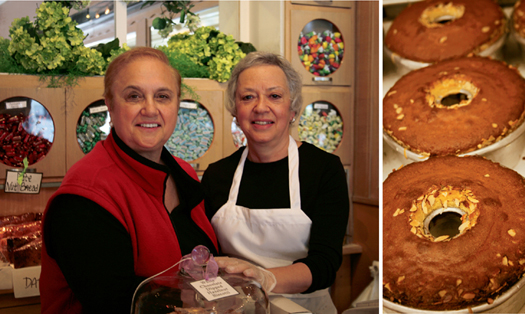
With Carol Scialo Gaeta at Scialo Bros. Bakery in Providence, Rhode Island; Carol’s famous butter rum cakes
Boston cream cakes do not sound Italian, but this recipe was given to me by Italians. At Scialo Brothers Bakery in Rhode Island, we found trays upon trays of little chocolate-covered spheres. I thought they were some version of a cassata (a Sicilian domelike cake stuffed with ricotta cream), but instead they were individual Boston cream pies. The French chef Sanzian, who worked at the Parker House Hotel (now the Omni Parker House) in Boston is credited with having invented the Boston cream pie. Italian or not, these were delicious.
MAKES 12
FOR THE PASTRY CREAM
½ cup sugar
4 teaspoons cornstarch
Pinch kosher salt
2 cups milk
2 large eggs
FOR THE CAKES
1½ cups all-purpose flour
1½ teaspoons baking powder
½ teaspoon baking soda
⅛ teaspoon kosher salt
6 tablespoons unsalted butter, softened
¾ cup sugar
2 large eggs
1 tablespoon extra-virgin olive oil
1 teaspoon vanilla extract
1 tablespoon orange zest
¾ cup freshly squeezed orange juice
FOR THE GLAZE
⅔ cup light corn syrup
2 tablespoons dark rum
Pinch kosher salt
8 ounces semisweet chocolate, finely chopped
Make the pastry cream: Whisk together the sugar, cornstarch, and salt in a medium pot. While whisking, pour in the milk. Set the pot over medium-low heat, and heat the mixture to just below boiling. Meanwhile, whisk the eggs in a large bowl. Remove the pot from heat, and pour the milk slowly into the eggs, whisking constantly, to temper the eggs. Pour the mixture back into the saucepan, and stir constantly over medium-low heat until the mixture thickens and just begins to simmer. Immediately scrape the mixture into a clean bowl. Let it cool slightly, then cover the surface of the pastry cream with plastic wrap. Refrigerate several hours or overnight, until chilled and thickened.
Make the cakes: Preheat the oven to 350 degrees F. Line a twelve-unit cupcake pan with paper liners. Sift together the flour, baking powder, baking soda, and salt onto a piece of parchment.
Cream the butter and sugar in a mixer fitted with the paddle attachment on medium-high speed until light and fluffy, about 2 minutes. Crack in the eggs, one at a time, mixing well between additions. Stir in the olive oil, vanilla, and zest. Beat on high speed for 2 minutes, to lighten and smooth the batter. Mix in the flour in three additions on low speed, alternating with the orange juice, beginning and ending with the flour. Once everything has been added, beat the batter on high speed for about 20 seconds.
Divide the batter evenly among the cupcake liners. Bake until a toothpick inserted in the center of a cupcake comes out clean, about 20 to 25 minutes. Remove the cupcakes from pan, and cool completely on a wire rack.
Make the glaze: Combine the corn syrup, rum, salt, and 2 tablespoons water in a small pot. Bring to a boil, and simmer until slightly thickened, about 2 minutes. Put the chopped chocolate in a heat-proof bowl, and pour the syrup over the chocolate. Stir until the glaze is smooth and shiny and all of the chocolate is melted. Let cool until thickened and just warm to the touch.
To assemble the cakes: Remove the cupcake liners from the cakes. Split the cakes at the base of the cap with a serrated knife.
To finish: Invert one cake, and place the cake cap on a plate, cut side up. Spoon the pastry cream onto the cake top, then top with inverted cake bottom, like an upside-down mushroom. Spoon the hot chocolate glaze onto the base facing you, letting the glaze run down the sides of the cake, spooning on more if necessary. Repeat with the remaining filled cakes.

This is a Cinderella dessert story. From simple leftovers—some coffee, leftover cake or cookies, an enrichment of cream or mascarpone—a prince of a dessert is born. Tiramisù is an Italian creation but its popularity in America began in San Francisco, and today it is as beloved in the United States as it is in Italy. In Italy this kind of dessert is categorized as dolce al cucchiaio (desserts to be eaten with a spoon), as is zuppa inglese.
Tiramisù can be made in advance, keeps well, is great to serve big numbers, and can even be frozen and remain delicious.
SERVES 10 OR MORE
1 pound bittersweet chocolate, chopped
2 cups heavy cream
2 cups mascarpone, at room temperature
1 cup confectioners’ sugar
2 cups freshly brewed espresso
½ cup granulated sugar
½ cup coffee liqueur
48 savoiardi cookies (ladyfingers)
Melt the chocolate in a double boiler over simmering water, and keep it warm in the double boiler.
Meanwhile, whisk the cream in an electric mixer fitted with the whisk attachment until it just holds soft peaks. (Don’t overwhip, because you will be whisking it again with the mascarpone, and you don’t want to make butter!)
Whisk the mascarpone in a separate bowl with the mixer on medium speed until smooth. Sift in the confectioners’ sugar and whisk until smooth. Whisk the whipped cream into the mascarpone until they are just combined. Refrigerate if not using right away.
Combine the espresso and granulated sugar in a medium saucepan set over low heat. Cook until the sugar has dissolved, then stir in the coffee liqueur. Remove from heat, and stir in about two-thirds of the melted chocolate. Pour the chocolate-espresso mixture into a large shallow pan, big enough to soak half the savoiardi at one time. Add half of the savoiardi to the soaking liquid, and soak, turning to coat all sides, until almost soaked through, about 1 minute.
Arrange the savoiardi in two rows in the bottom of an 9-by-13-inch (3-quart) Pyrex dish or ceramic dish to make a tight bottom layer, breaking as necessary to patch empty spaces. Drizzle with a third of the remaining warm melted chocolate. Spread half of the mascarpone in an even layer over the top of the cookies.
Soak the remaining twenty-four savoiardi in the remaining soaking liquid. (You should have used up most of the soaking liquid by this point.) Arrange the soaked savoiardi on top of the mascarpone, just as you did the first layer, and drizzle with another third of the warm melted chocolate.
Spread the remaining mascarpone in an even layer over top. Pour the remaining melted chocolate on top. Use a toothpick or paring knife to make lines at 2-inch intervals connecting the long sides of the pan. Now make perpendicular lines through the chocolate to create a crosshatch pattern. Chill the tiramisù at least 4 hours or up to overnight before cutting into squares to serve.
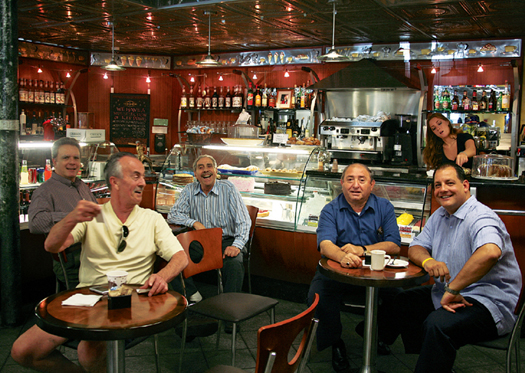
Italian American boys meet at Venda Ravioli, in DePasquale Plaza in the heart of Federal Hill in Providence, Rhode Island, for their mid-morning pick-me-up.
This moist, creamy, and flavorful dessert, zuppa inglese (“English soup”), has its roots in the English trifle and it was thought that it first appeared during World War II, when British soldiers were stationed in Italy with only meager custard rations. However, the recipe appears in Pellegrino Artusi’s book, published in 1891, before any Allied forces had been stationed in Italy. Other theories reach as far back as the Renaissance.
Zuppa inglese is traditionally made with sponge cake, but I use savoiardi (ladyfinger) cookies, as are used in tiramisù, hence making the assembly much quicker. This dessert was a staple of every Italian American restaurant, and every Italian bakery made a version of it.
SERVES 8 OR MORE
2 cups whole milk
1¾ cups sugar
4 teaspoons cornstarch
Pinch kosher salt
3 large eggs
2 ounces bittersweet chocolate, finely chopped
⅓ cup diced candied orange peel
¼ cup rum
2 cups heavy cream, chilled
⅛ teaspoon ground cinnamon
36 savoiardi cookies (ladyfingers)
For the pastry cream: Pour the milk into a medium saucepan set over low heat. Whisk in ½ cup sugar, the cornstarch, and pinch of salt, and bring the milk to a simmer, just to dissolve the sugar.
Whisk eggs in a medium bowl. While whisking, slowly pour the hot milk into the eggs to temper them, then pour the mixture back into the saucepan. Return the saucepan to medium-low heat, and cook, stirring and whisking, until the mixture just simmers and thickens. Immediately remove from the heat and scrape into a bowl to cool. Mix in the chocolate and orange peel. Refrigerate until chilled and thickened, at least 1 hour.
For the sugar syrup: Bring 3 cups water and 1 cup of the sugar to a boil in a saucepan. Boil until reduced by about a quarter. Remove from heat, stir in the rum, and let cool completely.
When you are ready to assemble the zuppa, whip the cream and remaining ¼ cup sugar to form soft peaks. Fold half of the whipped cream, along with the cinnamon, into the chilled pastry cream.
Make a flat layer with half of the savoiardi in a 9-by-13-inch Pyrex or ceramic dish. Brush with half of the sugar syrup to moisten, then spread half of the pastry cream on top. Top with another layer of savoiardi, and brush on the remaining syrup. Spread the rest of the pastry cream over top in an even layer, then spread with the whipped cream. If you have any savoiardi left, crumble them over the top. Chill several hours, or overnight, to let the flavors blend before serving.
Italian cheesecake is one of the easiest Italian desserts to make, and, yes, one can add raisins, orange, or pine nuts. But I recall my grandmother’s simple version, made from goat’s-milk ricotta with minimal sugar, and it was delicious. In America, the cream-cheese version, of much smoother consistency, is common, but an Italian will willingly partake of the crumbly consistency of ricotta cheesecake, any time.
SERVES 10 TO 12
2 tablespoons unsalted butter, softened
½ cup amaretto cookie crumbs (from about 4 or 5 amaretti)
½ cup golden raisins
3 tablespoons dark rum
5 large eggs
1 cup sugar
½ teaspoon kosher salt
4 cups drained fresh ricotta, at room temperature
1 cup mascarpone, at room temperature
Finely grated zest of 1 lemon
Finely grated zest of 1 orange
½ cup pine nuts, toasted
Preheat oven to 350 degrees F. Brush an 8-inch springform pan with butter on the bottom and sides. Coat the bottom and sides with amaretto crumbs, tapping out the excess. Put the raisins in a small bowl, and pour the rum over them. Let soak while you make the filling.
Beat the eggs, sugar, and salt in a mixer fitted with the whisk attachment on high speed until it is foamy and the sugar has dissolved and no longer feels grainy, about 2 minutes. Plop in the ricotta, mascarpone, and citrus zests. Strain into the batter the rum in which the raisins soaked, and mix on medium until smooth and fluffy, about another 2 minutes. Now fold in the raisins and pine nuts with a spatula.
Put the springform pan on a baking sheet, and pour the batter into the pan, smoothing the top with a spatula. Bake until the edges are set and light golden, but the center is still a bit jiggly, about 1 hour and 15 minutes. Cool completely on a wire rack before removing from pan and serving.
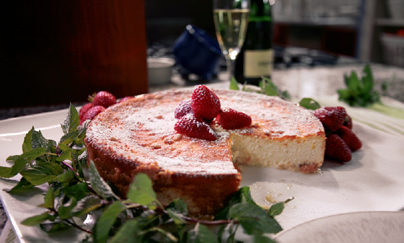
Italian Cheesecake
I picked up this simple, delicious, and very Italian cake on a visit to Angelo Brocato’s ice cream and confectionery in New Orleans. I am sure you will want to make this dessert over and over again. If you are going to freeze it, keep the taste fresh by wrapping it tightly in plastic.
SERVES 8 TO 10
FOR THE CRUST
12 chocolate graham-cracker sheets, crushed (about 2⅓ cups)
3 tablespoons sugar
2 tablespoons espresso powder
Pinch kosher salt
5 tablespoons unsalted butter, melted and cooled
FOR THE FILLING
1 quart coffee ice cream
2 cups heavy cream
2 tablespoons sugar
1 cup sour cream
Preheat the oven to 350 degrees F.
Grind together the graham crackers, sugar, espresso powder, and salt in a food processor to make fine crumbs. Add the melted butter with the processor running, and pulse just to combine. Press the crumbs into the bottom and up the sides of a buttered 8-inch pie plate, making sure the crumbs are evenly distributed. Bake the crust until crispy, about 10 to 12 minutes, then cool completely before filling.
Remove the ice cream from freezer to soften a bit while you make the whipped cream. Whip the cream and sugar in a mixer fitted with the whisk attachment, to form soft peaks. Add the sour cream, and whisk until just combined.
Spread the ice cream in an even layer over the crust. Dollop the whipped-cream mixture on top, and spread upward to a dome shape. Freeze overnight, or until the cream is frozen. To serve, cut with a sharp knife dipped in hot water.
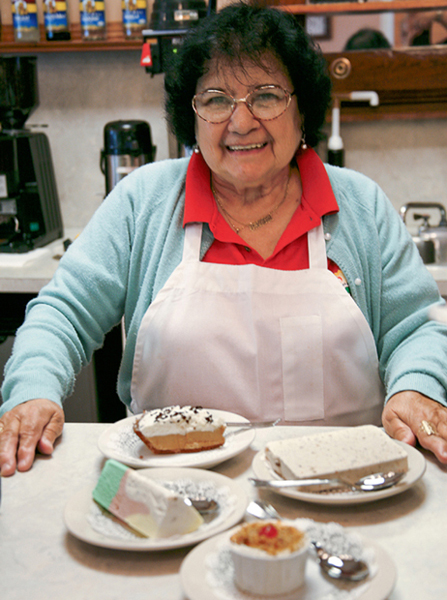
Michelina Brocato serving up gelato and cappuccino cake at Angelo Brocato’s in New Orleans
Incassare in Italian means “to put in a box,” and in this case the boxing consists of flavored ricotta in a light sponge cake, often decorated with candied fruits and chocolate. It is a dessert that, once filled and sealed, keeps well for a few days. That is why Italian American restaurants had it on the menu: low maintenance with good flavors. This versatile dessert can be filled with various flavors of ice cream, so try substituting that in place of the ricotta filling (in which case you will have to keep the cake in the freezer). Sicilian in origin, cassata is most easily found in areas of America that experienced a large influx of Sicilian immigrants, such as New Orleans.
SERVES 8 OR MORE
FOR THE CAKE
Butter, softened, for the cake pan
1 cup all-purpose flour, plus more for the cake pan
½ teaspoon baking powder
6 large eggs
¾ cup granulated sugar
Zest of 1 small orange
FOR THE FILLING
1½ teaspoons gelatin powder
3 cups fresh ricotta, drained
1 cup confectioners’ sugar
¼ cup finely chopped bittersweet chocolate
¼ cup finely chopped candied lemon peel
FOR THE SYRUP
5 tablespoons granulated sugar
2 tablespoons Grand Marnier
FOR THE GLAZE
1½ cups confectioners’ sugar, plus more if needed
3 tablespoons lemon juice
For the cake: Preheat the oven to 350 degrees F. Butter and flour the bottom and sides of a 9-inch springform pan. Sift together the flour and baking powder in a bowl.
Whisk the eggs in a mixer fitted with the whisk attachment on high speed until very light and fluffy, about 5 to 6 minutes. With the mixer on medium, slowly pour in the sugar, and mix until thick and glossy, about 1 to 2 minutes, then stir in the orange zest. Fold in the sifted flour with a spatula just until incorporated—don’t overmix. Pour the batter into the prepared pan, and bake until a cake tester inserted in the center comes out clean, about 20 minutes. Let the cake cool on a wire rack, then run a knife around the sides of the pan to loosen and unmold.
For the filling: Dissolve the gelatin in 2 tablespoons hot water in a small bowl. Beat the ricotta and confectioners’ sugar in a mixer fitted with the paddle attachment on medium speed until smooth, about 2 minutes. Scrape in the dissolved gelatin and mix to distribute. Stir in the chocolate and lemon peel with a spatula.
For the syrup: Bring the sugar to a boil with 1 cup water in a small pot. Boil until reduced by about a quarter, about 2 to 3 minutes. Remove from heat, and stir in the Grand Marnier. Let cool slightly.
To assemble: Line the inside of a 9-inch-diameter bowl with plastic wrap, letting several inches of excess wrap drape down the outside. Cut the cake into three circular layers of equal thickness, using a serrated knife. Line the bottom of bowl with one cake slice, pressing to fit, and brush with some of the syrup to soak it evenly. Fill half of the cavity of the bowl lined with the cake with some of the filling. Fit another cake layer on top of the filling, pressing to fit snugly to the sides of the bowl, then brush with more syrup. Continue to fill the cavity with the remaining filling, and fit the final layer flat on top. Soak the last layer with the remaining syrup. Fold the excess plastic wrap over the top, and weight top with a heavy plate. Chill overnight, or until the filling is set; if filled with ice cream, set in the freezer.
For the glaze: Sift the confectioners’ sugar into a large bowl, and whisk in the lemon juice to make a smooth, spreadable glaze. If necessary, add a little more confectioners’ sugar or some water to get the correct consistency.
Remove the cake from the bowl and unwrap. Invert with dome up on a cake plate or stand. Spread the glaze over the top of cake, and let it slide down the sides, guiding it with a spatula to cover the cake completely. Let the glaze set at room temperature before serving.

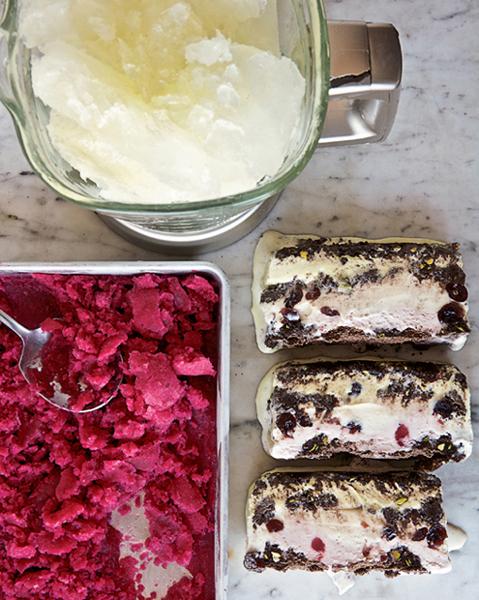
Lemon Granita (top), Prickly Pear Granita (left), and Spumoni (right)
Lemon ice is simple and delicious and very Italian. This recipe was given to me by Maria at Carm’s in Chicago. It was not too sweet, with a nice tartness, and a bit slushy when she served it to me; I loved it.
SERVES 12
4 cups water
1 cup sugar
¾ cup lemon juice (about 2 lemons)
Pour the water and sugar into a small saucepan, and bring to a boil. Boil until the sugar is completely dissolved. Remove from heat, and stir in the lemon juice. Let cool slightly.
Pour into twelve 8-ounce plastic or paper cups, and freeze overnight or until solid. For a granular ice another option is to put the lemon mixture in a wide ceramic baking pan and set it in the freezer, scraping and mixing it every half hour as it solidifies. When all the liquid has solidified into loose crystals it is ready to serve. Spoon into decorative glasses.

Maria de Vivo at Carm’s in Chicago serves me an absolutely delicious, mouth-puckering lemon ice.
Prickly pears—or fichi d’India, as they are called in Italy—grow wild and abundant in Sicily and are eaten simply as a fruit, as a salad, or churned into a dessert, as in this recipe for granita. In the Southwestern United States, the prickly pear grows abundant and wild, and when I visited the Salinas Valley in California, I was delighted to see acres upon acres of this cactus plant growing for commercial harvesting. The Mexican culture uses it in their cuisine, but I was especially happy to see a demand for it here in the States. When you find it nice and ripe in your market, buy it and make this simple and delicious granita with it.
SERVES 6 TO 8
10 prickly pears
Juice of 1 orange
Juice of 1 lemon
¼ cup sugar
Peel the skin from prickly pears (wear plastic gloves). Slice the flesh into pieces, then gently push the pear flesh through a medium-holed sieve, pressing the flesh and juice with a wooden spoon or spatula into a bowl, leaving the seeds behind in the sieve. You should have about 2 cups juice.
Mix the orange juice, lemon juice, and sugar into the prickly-pear juice in a bowl, stirring until the sugar dissolves. Pour the granita juice into an 8-inch square metal pan (or a similar size; you want the granita to be an inch deep or less).
Cover, and freeze the granita until crystals begin to form on the sides of the pan, about 30 minutes. Stir and scrape crystals and granita, breaking up any solid parts with a fork. Freeze until firm, scraping mixture with fork every 30 minutes to form icy crystals.
To serve, scrape granita into chilled serving glasses.
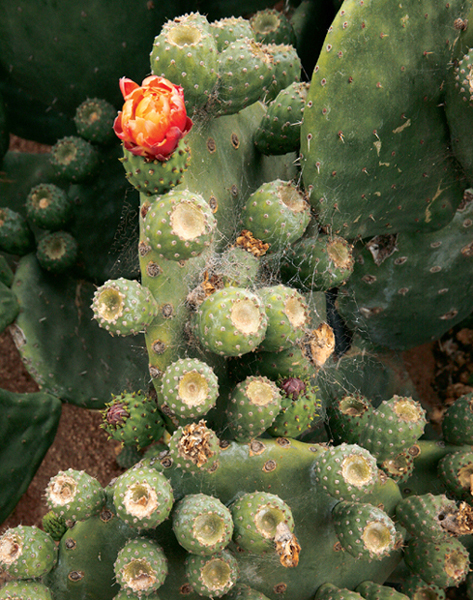
Prickly pears growing at Andy Boy Farms
Spumoni is a delicious dessert made from three flavors of ice cream stuffed into a cup, and cut in four when frozen. The ice-cream colors reflect the colors of the Italian flag—red, white, and green—and spumoni has long been a big item on the menus of Italian American restaurants. Spumoni has its origins in a Neapolitan dessert, and supposedly came to America in 1905 with Salvatore Lezza. Lezza’s spumoni can still be had on Chicago’s Upper West Side. I filled many a cup with my own homemade ice cream in my early restaurant days, in the seventies, but spumoni is still delicious when made with good store-bought ice cream as well.
Here rum gives the spumoni an extra layer of flavor, but the juice of the sour cherries is a great alternative.
SERVES 8 OR MORE
1 pint pistachio ice cream
1 pint vanilla ice cream
1 pint strawberry ice cream
8 sheets chocolate graham crackers
¼ cup rum (or juice from sour cherries; see below)
¼ cup finely chopped unsalted pistachios
One 15-ounce can pitted sour cherries, drained, juice reserved if desired (see above), cherries roughly chopped
Remove the ice cream from the freezer about 10 to 15 minutes before beginning, to let it soften. Line a 9-by-5-inch loaf pan with plastic wrap, letting about 3 or 4 inches hang over each edge.
Put the graham crackers in the bowl of a food processor, and pulse to make fine crumbs. Pour the crumbs into a medium bowl, drizzle with the rum or cherry juice, and add the pistachios. Toss to combine and moisten the crumbs with the rum or juice.
Sprinkle about a third of the crumbs in an even layer in the bottom of the loaf pan. Spread the pistachio ice cream on top in a flat, even layer. Sprinkle with half of the chopped drained cherries, then layer on another third of the crumbs. Spread the vanilla ice cream on top of the crumbs in a flat, even layer. Sprinkle with the remaining crumbs, then the remaining cherries. Spread the strawberry ice cream on top in a flat, even layer. Cover the top of the ice cream with the overhanging plastic wrap, and freeze overnight, or until firm throughout.
To serve: Let the spumoni sit out of the freezer for about 5 minutes. Unwrap, and cut into slices with a serrated knife dipped in hot water.
I guess you could call this silky chocolate milk, or luscious liquid chocolate pudding. I remember it as a very special treat when I was a child. It is simple and delicious, and, served with some Italian cookies, it becomes dessert.
SERVES 6
4 cups whole milk
¼ cup all-purpose flour
⅔ cup sugar
Peel of 1 orange, in thick strips
2 tablespoons unsalted butter
½ teaspoon vanilla extract
¼ teaspoon kosher salt
1 cup cocoa powder
Toasted brioche or plain cookies, for serving
Bring the milk just to a simmer in a sloped-sided medium pot (so the pudding will not stick in the corners of the pot). Ladle about ½ cup of the milk into a small bowl, and whisk in the flour to make a smooth paste. Whisk the flour paste back into the hot milk until smooth. Add the sugar, orange peel, butter, vanilla, and salt, and bring back to a simmer.
Pour the cocoa powder into a medium bowl. While whisking, gradually pour about 1 cup of the hot milk into the cocoa. Whisk until smooth, then whisk the cocoa and milk back into the pot. Bring the soup to a simmer, whisking constantly, and making sure you get into the corners of the pot. Let simmer until thickened, about 3 minutes. Strain through a sieve into a clean pot. Serve hot in bowls, with brioche or plain cookies for dipping.
I am sure just about everyone who has traveled to Italy was offered limoncello at some point or other during the trip. This delightful lemon-flavored drink is a custom born in southern Italy, but now limoncello has crossed into not only all of Italy, but also across the Atlantic and into the United States. You can now make limoncello easily at home—no need to travel—and this recipe also works well with oranges. Limoncello is best served cold. Keep a bottle in the freezer for your guests.
MAKES 1½ QUARTS
Peel of 15 lemons
750-milliliter bottle of vodka
3½ cups water
2½ cups sugar
Wash and pat dry the lemons. Use a vegetable peeler to zest them, making sure to omit the white pith. (The pith would make the limoncello bitter.)
Stir the lemon peels into the vodka in a glass jar. Cover, and keep in a cool, dark place for 30 days. (There is no need to stir or mix the liquid.) When it is ready, the liquid will smell strongly of lemon rinds and be a deep-yellow color.
Bring water and sugar to a boil and boil for 5 to 7 minutes; let cool.
Add sugar syrup to the vodka and lemon zest, stir, and let rest for an additional 30 days, to let the flavors further mellow and blend with the sugar syrup.
Strain the limoncello through a moistened cheesecloth or coffee filters. Discard the lemon zest, pour the strained limoncello into your choice of bottle, and seal tightly.